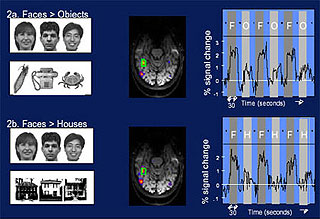
Comparison of sample fMRI scans of the brains of subjects looking at faces versus objects (top), and faces versus houses (bottom). (Image courtesy of Kanwisher Laboratory, MIT Department of Brain and Cognitive Sciences. Used with permission.)
Instructor(s)
Prof. Nancy Kanwisher
MIT Course Number
9.71
As Taught In
Fall 2007
Level
Undergraduate
Course Description
Course Description
We are now at an unprecedented point in the field of neuroscience: We can watch the human brain in action as it sees, thinks, decides, reads, and remembers. Functional magnetic resonance imaging (fMRI) is the only method that enables us to monitor local neural activity in the normal human brain in a noninvasive fashion and with good spatial resolution. A large number of far-reaching and fundamental questions about the human mind and brain can now be answered using straightforward applications of this technology. This is particularly true in the area of high-level vision, the study of how we interpret and use visual information including object recognition, mental imagery, visual attention, perceptual awareness, visually guided action, and visual memory.
The goals of this course are to help students become savvy and critical readers of the current neuroimaging literature, to understand the strengths and weaknesses of the technique, and to design their own cutting-edge, theoretically motivated studies. Students will read, present to the class, and critique recently published neuroimaging articles, as well as write detailed proposals for experiments of their own. Lectures will cover the theoretical background on some of the major areas in high-level vision, as well as an overview of what fMRI has taught us and can in future teach us about each of these topics. Lectures and discussions will also cover fMRI methods and experimental design. A prior course in statistics and at least one course in perception or cognition are required.
Other Versions
Other OCW Versions
Archived versions: ![]()


